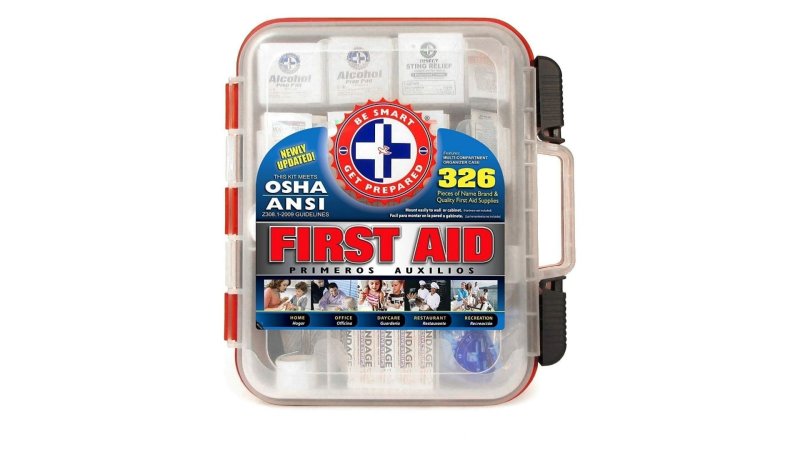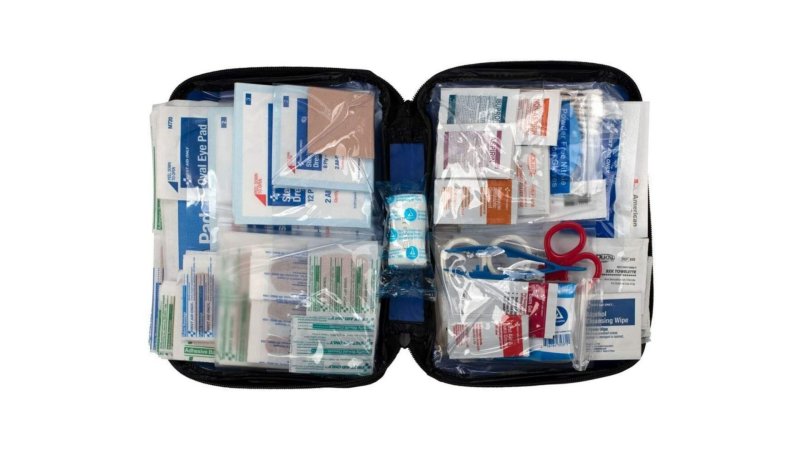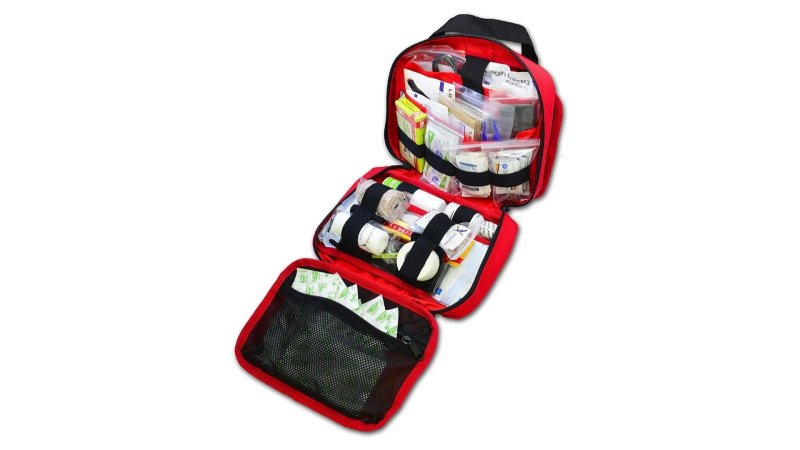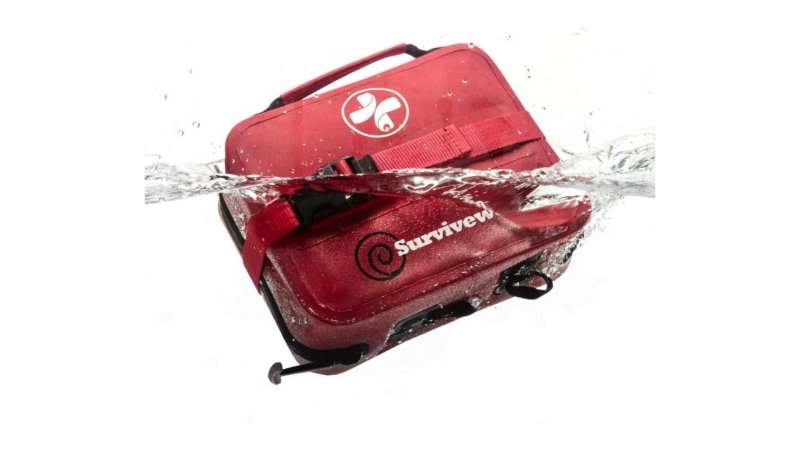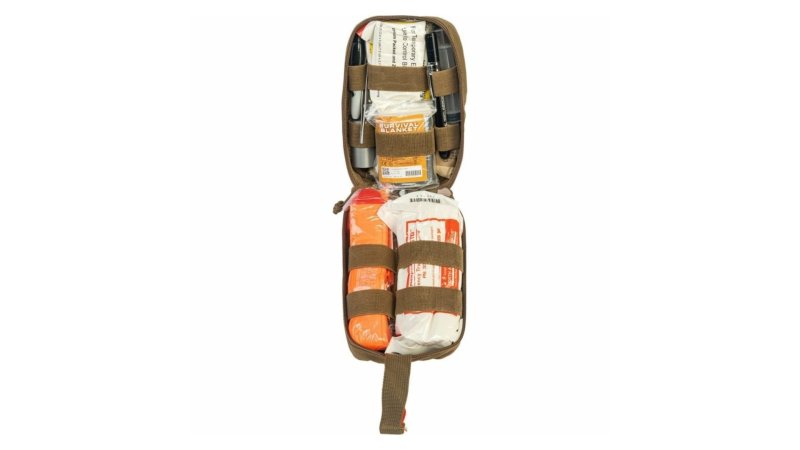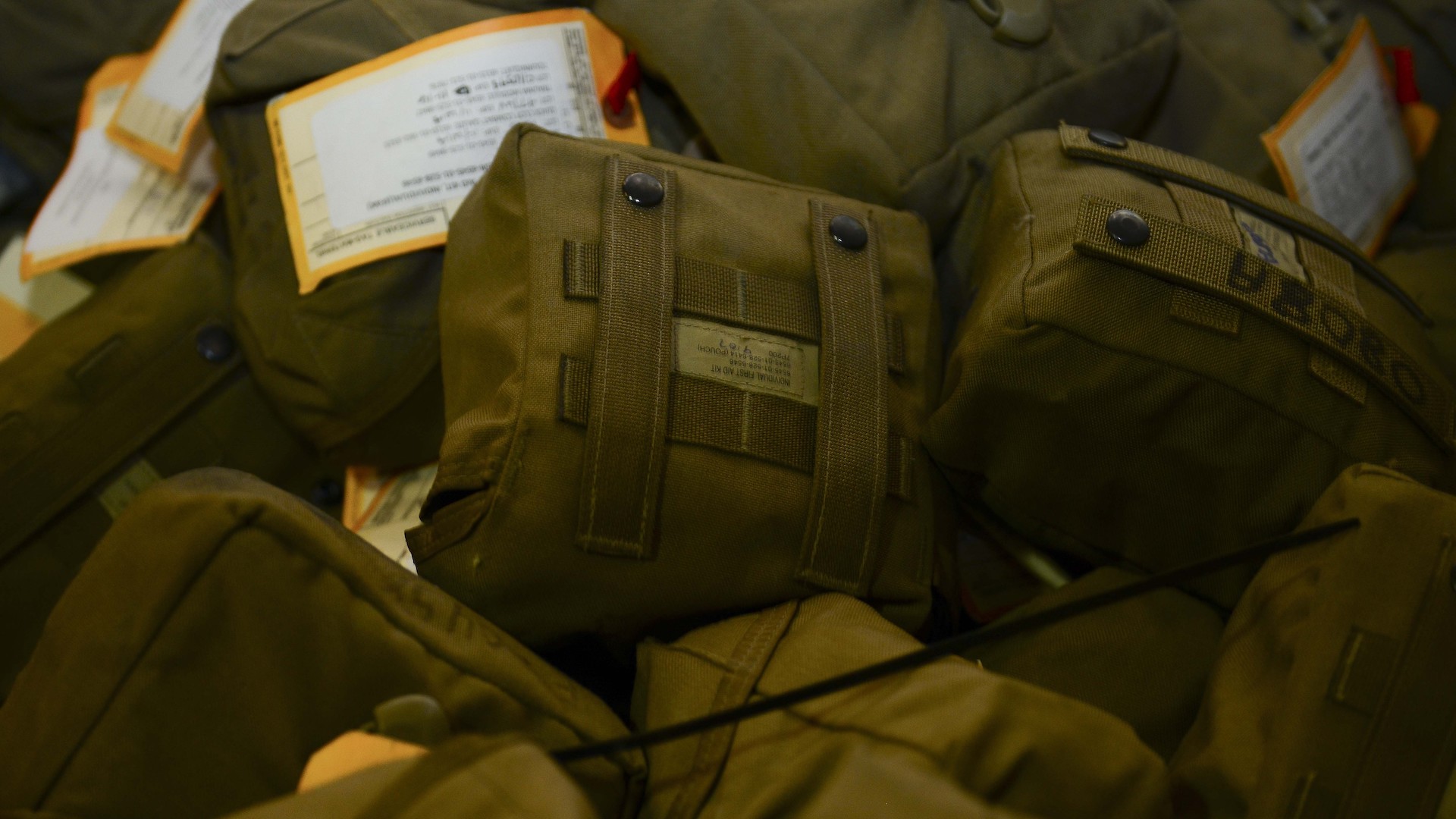

We may earn revenue from the products available on this page and participate in affiliate programs.
Ever heard of Murphy? You know, that guy whose law can both be a big pain and cause big pain? He has a way of wrecking life’s best-laid plans (and your ER budget), but when you prepare for his next visit, it becomes a bit less memorable and a bit less painful — especially when that preparation puts one of the best first aid kits front and center.
Oddly enough, though, shopping for first aid kits can be a bit more challenging than you might expect, and when words like “sterile”, “acetaminophen”, and “trauma” show up on a shopping list, it gets incredibly easy to “forget” what you need a grab the simplest looking item on the shelf, putting both your wallet and your churning stomach a bit more at ease. Murphy likes it that way, but we don’t.
To that end, we put together a guide to the best first aid kits on the market to boost your confidence and peace of mind while taking some spring out of Murphy’s step.
Best Overall
Be Smart Get Prepared 326-Piece First Aid Kit
Pros
- OSHA-compliant
- Well-rounded supply list
- Good organization
- Can be wall-mounted
Cons
- Not travel friendly
- May require minor upgrades for some users
Product Specs
- Type: General Purpose
- Container: Water-resistant hard plastic clamshell
- Organization: Tiltable hard plastic slots
Best Budget
First Aid Only 299-Piece All-Purpose First Aid Kit
Pros
- Affordable
- Good supply list
- Lightweight design
- Portable
Cons
- Limited organization
- Not OSHA-compliant
- Requires minor upgrades for some users
Product Specs
- Type: General Purpose
- Container: Soft zippered clamshell
- Organization: Transparent interior pockets
Editor’s Choice
Lightning X Rip-Away Vehicle Headrest First Aid Kit
Pros
- Good organization
- Excellent supply list Includes
- MOLLE-compatible hook-and-loop mounting base
Cons
- Expensive
- Lacks common over-the-counter meds
Product Specs
- Type: Advanced
- Container: Zippered nylon case with hook-and-loop mounting base
- Organization: Interior nylon pockets, elastic retention bands, and zippered mesh pouch
Best Waterproof First Aid Kit
Surviveware Large Waterproof First Aid Kit
Pros
- Very good organization with clear labels
- Very good supply list
- Includes breakaway miniature first aid kit
- HSA/FSA-eligible
Cons
- Expensive
- Lacks common over-the-counter meds, large splint
Product Specs
- Type: Advanced
- Container: IPX7 waterproof, zippered 600D TPU pouch with hook-and-loop mounting base
- Organization: Interior mesh pockets with content labels
Best EDC First Aid Kit
North American Rescue Solo IFAK
Pros
- Offers treatment options for minor, major, and traumatic injuries
- Lightweight for the supply list
- MOLLE compatible
Cons
- Expensive
- Limited supply quantities
- May require minor upgrades for some users
Product Specs
- Type: Specialty
- Container: Zippered nylon pouch with PALS webbing and MOLLE-compatible mounting base
- Organization: Interior webbing
Why you should trust us
Prior to my career as a writer, I spent years as a professional lifeguard and lifeguard instructor. During that time, I spent plenty of time using first aid equipment and various pieces of medical gear, and I learned the difference between quality medical equipment that serves a valuable role in emergency situations and cheap garbage that only gets in the way. In the past, I have covered life-saving emergency gear for Task & Purpose, and you can rest assured that I refuse to recommend or highlight any gear that I would not trust for my own use.
That said, I am well aware that my own medical training has its limits, and my conscience dictates that whenever I hit those limits, I will defer to those who are better qualified than I am to address the topic. Your safety and success will always come first.
Types of first aid kits
Imagine trying to administer care to a battlefield casualty with a home-oriented first aid kit. To the uninitiated, a first aid kit is a one-size-fits-all solution, but the reality is that first aid kits come in a variety of shapes and sizes with unique loadouts. Your individual setting(s), training, and the people around you directly affect what kind of first aid kit you will need. Choose wisely.
Boo-boo kit
The bare bones “boo-boo kit” wins the dubious distinction of being the most common “first aid kit” on the market today. Walk into any Walmart, Target, CVS, or Walgreens, and these kits will make up the bulk of available options before you. These low-cost kits tend to be small and compact, making them convenient for treating minor cuts, scrapes, headaches, and other low-key maladies.
In the truest sense, these kits barely qualify as first aid kits if at all, but they do fit nicely inside glove boxes, purses, and other tight spaces. Of course, one upside to this diminutive first aid kit is the lack of need for first aid training.
Along with manufacturer-dependent extras, a typical boo-boo kit will include the following essentials:
- Disposable sterile gloves
- Alcohol wipes
- Antibiotic/antibiotic wipes
- Antiseptic/antiseptic wipes
- Burn cream
- Sting relief wipes
- Adhesive bandages
- Butterfly closures
- Sterile gauze pads
- Adhesive tape
- First aid guide
General-purpose first aid kit
Everyone should have a good general-purpose first aid kit kicking around the house or the car. While these kits do include the first aid equipment found in the most basic drug store kits, a boo-boo kit this is not. In our humble estimation, these kits are the bare minimum for most settings. General-purpose first aid kits provide proper care equipment for basic emergencies, such as light to medium bleeding, sprains, broken bones, and diabetic emergencies.
General-purpose first aid kits commonly appear in well-equipped homes and vehicles. Thankfully, basic first aid training usually is not required with these kits as they often include an adequate first aid guide. That said, don’t skip basic first aid training if you can help it.
A good general-purpose first aid kit will include most or all of the following:
- All boo-boo kit essentials
- Cotton swabs
- Gauze rolls
- Triangular bandage
- Moleskin
- Scissors/shears
- Safety pins
- Splint materials (fingers and/or limbs)
- Thermometer
- Tweezers
- Cold pack
- Emergency blanket
- Glucose/sugar tablets
- Acetaminophen (Tylenol)
- Aspirin
- Ibuprofen (Advil/Motrin)
- Plastic bag
Advanced first aid kit
Emergencies requiring more than patching up common wounds and taming other routine maladies also require the use of an advanced first aid kit. These kits easily handle basic emergencies while also equipping first responders to respond to more traumatic injuries and to provide basic life support, making CPR equipment a crucial component. While you may know an EMT or other professional first responder who regularly carries a kit like this, these first aid kits are not the same as an EMT bag.
Advanced first aid kits include most or all of the supplies you would expect to find in a general-purpose kit but with a handful of critical extras. Other extras often include:
- Antihistamine
- Compressed gauze
- Trauma pads
- Eye pads
- Tourniquet
- Saline/eye wash
- Permanent marker/pen
Specialty first aid kit
Specialty first aid kits are a breed all their own, and if you’re a nerd like us, this is where things get fun. These first aid kits run the gamut in terms of both size and equipment and have equipment lists tailored to specific occupations, activities, or environments. Frequently, these kits are customized to address activity-specific injuries, handle traumatic injuries, and/or provide basic life support. Due to size and weight considerations, they also may decrease the amount of included “boo-boo” gear (think a military-issued IFAK).
Specialty first aid kits often come fully equipped with everything you’d expect in a general-purpose kit or even an advanced kit but with a number of extra “goodies”, such as the decompression needles, QuikClot gauze, chest seals, or nasopharyngeal airways found in “trauma kits”. Obviously, specific equipment lists will vary widely, and in many cases, the gear list will require specialized first aid training in order to be used properly. Make sure to train accordingly.
Key features of first aid kits
Contents list
First aid kits include a wide variety of emergency medical equipment, and as such, each kit requires the user to have received some degree of first aid training. For many, that training may simply be a completion of the core medical course in Life’s School of Hard Knocks. For others, however, an American Red Cross first aid certification, a combat medic’s course, or full-fledged EMT training may fill that role instead. Whatever the case may be, make sure your first aid kit of choice is up to the task of matching your level of training.
When selecting a first aid kit, find one with supplies and equipment commensurate to your current level. Due to the legal dangers of exceeding your level of training during a medical emergency, wisdom dictates keeping equipment designed for higher degrees of care out of sight and out of mind. Remember, you can always upgrade or add to your kit later.
Storage container
When purchasing a first aid kit, make sure to consider where you plan to store and use it. In order to maintain medical integrity, first aid equipment should always be kept dry and, ideally, stored in a temperate climate. A proper storage container will achieve these goals while also promoting ease of access and clear organization.
When selecting a wall-mounted first aid kit, consider whether or not it will be installed indoors or out. If stored outdoors or in a wet or humid indoor environment, find one that will seal tightly and keep water out. A tough exterior and internal shelving are absolute necessities.
A good portable first aid kit will require a bit more from its storage container. For marine environments, a completely watertight, corrosion-resistant container is the only option. For outdoorsmen, law enforcement, or military personnel, full waterproofing may not be essential, but strong water resistance absolutely is. For these users, minimal weight, durability, clear organization, and convenient attachment points are critical features.
OSHA compliance
These (slightly upgraded) general-purpose first aid kits comply with the Occupational Safety and Health Administration’s standards for medical supplies available in the workplace. All OSHA-compliant first aid kits must be fully stocked with specific emergency medical supplies. For a small workplace (2-3 employees), an OSHA-compliant first aid kit must include at minimum:
- Latex gloves
- Other personal protective equipment (such as eye pro, face shields, gowns, etc.) if exposure to blood or infectious materials may be “reasonably anticipated” while using first aid equipment
- CPR equipment (such as a pocket mask or disposable CPR face shield)
- Wound cleaning agents (such as sealed moistened towelettes)
- Adhesive bandages (one box)
- Gauze pads, at least 4 x 4 inches
- 2x Gauze pads (large), at least 8 x 10 inches
- 1x Gauze roller bandage, at least 2 inches wide
- 2x Triangular bandages
- 2x Elastic wraps
- Adhesive tape
- Blanket (at least one)
- Splint
- Scissors
- Tweezers
- Directions for requesting emergency assistance
OSHA compliance is a non-essential feature for non-business owners; however, standardization has the advantage of providing consumers with a predictable product. If you’re looking to cover the basics, OSHA kits offer a solid, if barebones, option.
HSA/FSA eligibility
The insurance world can be a confusing mess, but if you are enrolled in either a health savings account (HSA) or flexible savings account (FSA), then you could be entitled to compensation. (And, no, this isn’t a late-night infomercial.) While insurance plans vary, most health/flexible savings accounts allow you to purchase a qualified first aid kit from your account without dipping into your take-home pay. First aid kits tend to be quite affordable, but if you find one marked as “HSA/FSA-approved”, you may have just found a tax-free emergency kit.
HSA/FSA-qualified first aid kits come in a variety of shapes and sizes, but to qualify as an approved purchase, the entire kit must be stocked only with HSA/FSA-approved equipment. While some approved kits may only meet boo-boo kit standards, most raise the bar to “OSHA plus” standards. Frequently, these kits exceed general-purpose first aid kit standards, and many combine the best of both these and OSHA-compliant kits, making them an excellent choice for those tax-free dollars.
Benefits of first aid kits
Be responsible
By their very nature, emergencies are out of our control, and as the saying goes, “failing to plan is planning to fail.” Unless you keep a first aid kit quickly and easily accessible, the proper care equipment is never around when serious bleeding, deep wounds, or heart attacks rear their ugly heads. A quality first aid kit allows for fast response times without the need to rummage around for gauze, butterfly closures, or aspirin. A properly stocked and stage first aid kit can even mean the difference between life and death.
Medical emergencies often occur at random times, and being prepared is a responsible approach to life. Car wrecks, natural disasters, and other dangers usually strike without warning, and access to timely professional medical help may be completely out of the question. With a quality first aid kit fine-tuned to your environment, you can short circuit Murphy’s Law whenever the fiend comes calling.
Pricing considerations of first aid-kits
Basic
Whether of the online or brick and mortar persuasion, big box stores frequently offer first aid kits at bargain prices, often for less than the cost of a new hoodie. First aid kits with price tags south of $35 tend to fall into one of two categories: boo-boo kits and low-budget general-purpose kits.
Boo-boo kits in this range run the gamut from minimalistic jokes to packed-out kits for everyday cuts and scrapes. General-purpose kits in this price range tend to be limited in the number and range of supplies and equipment, bypassing valuable extras in favor of value prices (and LOTS of Band-Aids). They also tend to lack organizational prowess, and larger kits usually fail to meet OSHA compliance standards.
Mid-range
If you take first aid kits a bit more seriously, then expect to leave somewhere between $35 and $70 at the register. That said, these kits tend to be higher quality and usually fall into the general purpose and advanced first aid kit categories. (Please don’t drop $70 on a boo-boo kit!)
With a higher price tag comes a better supply list. Instead of including 5 million Band-Aids, these kits frequently feature more and better equipment than their budget-conscious brothers. Items like burn treatment creams or ointments, reusable splints, and other upgraded equipment start to get included, and in general, the basics also tend to be of higher quality. Clear organization is another common upgrade in this price range, and while not every kit is OSHA-compliant, those that are tend to offer more impressive supply lists and quantities.
Premium
If you have any sort of professional experience in first aid or emergency medical care, you’ll likely find yourself wanting to expand your budget a bit. For many advanced and/or specialty first aid kits, price tags usually exceed $70, and the best kits can easily run into the realm of triple digits. Still, the payoff is worth it.
Ironically, while most high-end kits tend to ignore OSHA standards for what makes a good first aid kit, they often allow users to exceed the standard of care associated with basic first aid training. This is particularly true of specialty kits, yet some top-of-the-line advanced kits may include penlights, quality (i.e., trustworthy) tourniquets, or hemostatic dressings or agents. These kits also tend to be well organized and may even include supply labels, a subtle yet professional touch.
How we chose our top picks
Identifying a good first aid kit can be a challenge even for experienced individuals. Due to the diversity of needs of each reader, I looked for a kit contents list that was as comprehensive as possible in light of the kit’s type, price range, and intended use. I took a close look at bonus features, like OSHA compliance and FSA/HSA eligibility, and supply quality, bypassing anything with suspect equipment, such as cheap or knock-off tourniquets. I also considered each kit’s case design, looking at durability for the kit’s intended use, internal organizational features, and overall size and weight. Throughout the process, I relied heavily on my own past knowledge and experience as a professional lifeguard and lifeguard trainer. When it came to understanding IFAKs, like the North American Rescue Solo IFAK, I took some queues from our own Travis Pike, combining his knowledge with my own.
FAQs on first aid kids
You’ve got questions, Task & Purpose has answers.
Q: Why do I need a first aid kit.
A: People do stupid things; ergo, you need a first aid kit. Oh yeah, and accidents can happen at the most random times. Like the time I sliced myself with my Buck Cadet. While opening a package. For a plastic pie server. (How did I get this job again?)
Q: What should I look for in a first aid kit
A: A first aid kit’s contents will vary widely from kit to kit, but the chances are if you don’t know what something is or how/when to use it, then you probably shouldn’t get it.
Q: Where should I keep a first aid kit?
A: Wherever you think you’ll need one. In your glove box, under your sink … just keep it easily accessible. Personally, I carry one with me everywhere I go, but then again, I’m weird like that.
Q: Do first aid kits expire?
A: No, but some components may need to be replaced from time to time. Most over-the-counter medications never expire; however, they will slowly lose potency over the years. Bandages and dressings require dry, sealed packages to maintain their sterile integrity. Gel packets, alcohol wipes, and similar supplies will eventually dry out over time and need to be replaced every so often.
Q: Are there any first aid kit regulations I should be aware of?
A: To my knowledge, there are no regulations on first aid kits. That said, there are plenty of laws and other restrictions surrounding the administration of first aid. The most significant are Good Samaritan laws and laws restricting who can administer medications in an emergency.
Q: What should a first aid kit include for patching?
A: This will vary from kit to kit depending on a given first aid kit’s intended purpose. As of late 2021, common OSHA-compliant kits must include (at minimum): a box of adhesive bandages, multiple gauze pads (at least 4 by 4-inches), two large gauze pads (at least 8 x 10 inches), and one roller gauze bandage (at least 2 inches wide).
Q: Can I take a first aid kit on a plane?
A: Absolutely. Unless you plan to pack along an emergency knife, carrying a first aid kit onto a plane shouldn’t cause any issues. The only potential issue you might run into is if you include trauma shears in your kit (a rare add-on). I’ve only taken trauma shears through TSA a handful of times, but I haven’t had any issues. Your mileage may vary.
Q: How much does a first aid kit weight?
A: In general, first aid kits tend to weigh in somewhere between one and three pounds. That said, each kit is different, and I’ve seen kits above and below those numbers.
Q: Do I need to consult a physician or medical professional to approve first aid supplies at my business?
A: Workplace first aid supplies are dictated by OSHA standards, and all OSHA-mandated first aid equipment can be purchased without restriction at Amazon, CVS, Walmart, etc. Of course, none of your supplies are any good if no one knows how to use them. Get yourself and your staff first aid certified.
Q: Should first aid kits be regularly inspected to ensure contents are complete and up to date
A: Absolutely. During my time as a lifeguard and assistant pool manager, my staff and I regularly checked the status of our first aid kits.
Q: Can over-the-counter medicines be put in first aid kits?
A: Yes, although which over-the-counter medications a first aid kit includes will depend somewhat on its intended use case(s). First aid kits frequently include acetaminophen (Tylenol), aspirin, ibuprofen (Advil/Motrin), a topical antiseptic, and a topical antibiotic. They may also include sugar/glucose tablets, burn cream, or sting relief wipes.
Our gear section
For over 25 years, Brian Smyth has been neighbors with the Air Force Academy and the U.S. Army’s Ivy Division. He loves the challenge of crafting words and has written for The Drive, Car Bibles, and other publications. Nothing gets him going quite like the roar of dual Pratt & Whitneys overhead, the smell of cordite, and the stories of the Greatest Generation.
